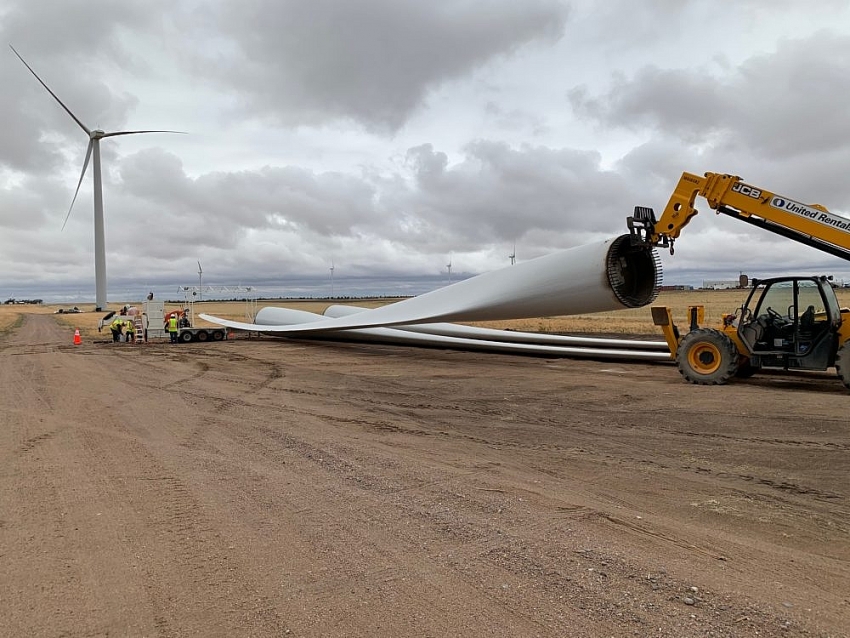GE Renewable Energy announces US blade recycling contract with Veolia
 |
| GE Renewable Energy and Veolia will reuse wind turbine blades as raw material for cement |
Veolia will process the blades of GE Renewable Energy for use as a raw material for cement, utilising a cement kiln coprocessing technology. VNA has a successful history of supplying repurposed engineered materials to the cement industry. Similar recycling processes in Europe have been proven to be effective at a commercial scale.
As part of the agreement, blades that have been removed from turbines will be shredded at VNA’s processing facility in Missouri and then used as a replacement for coal, sand, and clay at cement manufacturing facilities across the US. On average, nearly 90 per cent of the blade material, by weight, will be reused as a repurposed engineered material for cement production. More than 65 per cent of the blade weight replaces raw materials that would otherwise be added to the kiln to create the cement, and about 28 per cent of the blade weight provides energy for the chemical reaction that takes place in the kiln.
Anne McEntee, CEO of GE Renewable Energy’s Digital Services business, said, “The sustainable disposal of composites such as wind turbine blades has been a challenge, not only for the wind turbine industry but also for the aerospace, maritime, automotive, and construction industries. VNA’s unique offering provides the opportunity to scale up and deploy quickly in North America, with minimum disruption to customers and significant benefits to the environment. We look forward to working with them on this effort to create a circular economy for composite materials.”
Wind turbine blades may be replaced through turbine improvement or “repowering” efforts, when specific elements of the turbine are upgraded to improve the efficiency and lifespan of the turbine, without replacing the entire machine. Longer, lighter blades help the turbine to generate more energy every year, providing even more renewable energy to end customers.
Bob Cappadona, COO for VNA’s Environmental Solutions and Services division, said, “By adding wind turbine blades – which are primarily made of fiberglass – to replace raw materials for cement manufacturing, we are reducing the amount of coal, sand, and minerals that are needed to produce the cement, ultimately resulting in greener cement that can be used for a variety of products. Last summer we completed a trial using a GE blade, and we were very happy with the results. This fall, we have processed more than 100 blades so far, and our customers have been very pleased with the product. Wind turbine blade repurposing is another example of Veolia’s commitment to a circular economy and ecological transformation in which sustainability and economic growth go hand in hand.”
VNA employs 20 people from the area at the Missouri processing facility, which is located about 70 miles northwest of St. Louis.
An environmental impact analysis conducted by Quantis US found that the net effect of blade recycling through cement kiln coprocessing is positive in all categories. Compared to traditional cement manufacturing, blade recycling enables a 27 per cent net reduction in CO₂ emissions from cement production and a 13 per cent net reduced water consumption. In addition, a single wind turbine blade that weighs 7 US tonnes recycled through this process enables the cement kiln to avoid consuming nearly 5 tonnes of coal, 2.7 tonnes of silica, 1.9 tonnes of limestone, and nearly a tonne of additional mineral-based raw materials. Largely due to the avoided coal consumption, this type of blade recycling also has a net-positive environmental impact in the categories of human health, ecosystem quality, and resource consumption. The resulting cement has the same properties and performance as cement manufactured using traditional means, meeting all applicable ASTM standards.
Recycling decommissioned wind turbine blades into cement production will aid the cement industry in its efforts to decarbonise. Likewise, GE Renewable Energy is committed to reducing environmental impacts throughout the life cycle of its products, including by announcing an ambitious pledge in 2019 to decarbonise its operations and achieve carbon neutrality by the end of 2020. GE Renewable Energy’s businesses are regularly partnering up with other leaders across the value chain to drive innovation for improved sustainability.
What the stars mean:
★ Poor ★ ★ Promising ★★★ Good ★★★★ Very good ★★★★★ Exceptional
Related Contents
Latest News
More News
- Addressing Vietnam's energy challenges with aeroderivative gas turbines (February 28, 2023 | 09:33)
- How to sprint ahead in 2023’s worldwide energy priorities (February 08, 2023 | 13:55)
- Boosting Vietnam's grid stability through gas turbine technology (November 22, 2022 | 20:02)
- Healthcare trio collaborates to provide thousands of free breast scans (October 27, 2022 | 17:19)
- GE Healthcare's vision for AI-backed radiology (September 29, 2022 | 11:53)
- GE brand trio to shape the future of key industries (July 19, 2022 | 15:35)
- GE unveiling brand names and defining future (July 19, 2022 | 15:16)
- GE: the shortest route towards sustainability (July 18, 2022 | 08:00)
- Be proactive in an uncertain world (May 20, 2022 | 11:40)
- GE secures first 9HA combined cycle power plant order in Vietnam (May 16, 2022 | 17:06)

 Tag:
Tag:





















 Mobile Version
Mobile Version